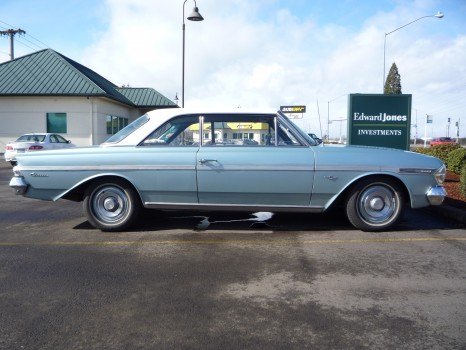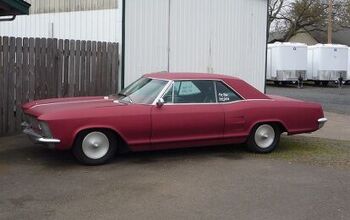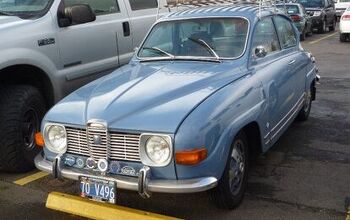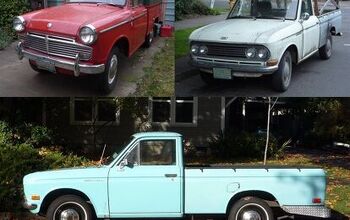Curbside Classics: 1964 Rambler Classic

What makes a car a true classic? Being one of the handsomest and most enduring designs of its time? Staying in production for twenty years? Having a long-stroke in-line engine with a classic OHC hemi-head? Winning a big race at the ’Ring? Having illustrious heads of state as loyal owners? Or just slapping a chrome “Classic” badge on its flanks? How does this Rambler stack up? Has it earned its chops, or is it an impostor?
In 1963, a professor in Iowa City bought a Classic hardtop like this for his wife. As I walked by it every day on my trudge to school, I gave the Rambler a whole lot more eyeball time than average. Being an OCD car gazer, that’s saying something.
This Classic challenged all my constructs about Ramblers: they just weren’t cool, period. Popular enough with the thrifty folks in the Midwest, their styling was atrocious. The 1961-1963 Rambler American takes the cake as one of the all-time stinkers. And I’ll never forget the shock of going to the dealer and lifting a hood on a ’63 American: it still had a flathead six, with only 90 hp! It was the last flathead engine still being made.
But that all began to change in 1963, after Dick Teague became chief stylist. Teague faced a momentous challenge: how to replace both the compact American and the mid/full size Classic and Ambassador with AMC’s limited budget. The answer was a brilliant two-in-one deal. The dramatically clean and handsome Classic/Ambassador sedans and wagons arrived in 1963, (rightfully) winning Motor Trend’s COTY. Teague cleaned it up even more for ’64, and added this particularly attractive hardtop coupe, Rambler’s first ever. Compared to the bloated and often fussy competition with their huge front and rear overhangs, this Classic was almost European in size, trimness, and cleanness of line.
Teague’s Act II was the compact ’64 American. By simply narrowing and shortening the unibody Classic platform, the American recycled the same doors, roof line, and many other body parts, not to mention the drive train and suspension. Rambler pioneered then what Audi “(re)invented” for its current range: a single set of platform components to cover their compact (A4), midsize (A6), and full-size (A8).
The only thing that spoiled these cars was the engines. The six was an OHV conversion of the old Nash flathead, and the 287 cubic inch V8 a small-bore version of the already obsolete AMC 327. The V8s were too heavy, casting a sentence of terminal understeer to the handling. But even with its Flash-O-Matic slushbox, this V8 Classic was reasonably lively in its day.
In production for twenty years? Not here in ADD-afflicted America, no thank you. When the Classic was restyled for again 1966, the blueprints and dies were bought by Kaiser’s Argentinean operation, IKA. The middle section of the Classic was mated with the front and rear of the American to create the Torino. In production until 1982, it became quite the legend.
Pop a Ritalin, because this story gets complicated. Renault bought IKA in 1975. So Renault was actually building AMC-designed cars in Argentina five years before they bought AMC. Maybe they were impressed by the Torino?
When Kaiser bought the Classic from AMC, it came sans engine. So Kaiser rummaged through its US warehouse and found just the thing for the Torino: the Kaiser Tornado straight six.
Back when Kaiser still owned Jeep (before selling it to AMC in 1970), it needed something fresher than its ancient old Continental-designed flathead six for the all-new 1963 Wagoneer. On a tiny budget, Kaiser’s Italian chief engineer designed a classic European-style OHC hemi-head. But under that new alloy head sat the old flathead block. But who knew?
America’s first main-stream OHC engine, the Tornado something of a (brief) sensation, until it started leaking and burning oil, overheating, and warping its beautiful aluminum cylinder heads. So in 1966, the Tornado was given a one-way ticket to Argentina, and Kaiser/Jeep started buying engines from . . . AMC!
But the Argentineans welcomed the Tornado with open arms, and began a steady development program that ended up with the 380W. Sporting three horizontally-mounted Webers, it cranked out over 300 hp (220 net). The Torino was the GTO/Hemi ’Cuda of Argentina. And so it went racing.
In 1969 three Torinos were sent to the 84 hour endurance race at Nurburgring. Amazingly, they won their class, and were a threat to the overall winner. Not bad, for an engine running a huge 4.38″ stroke in its antediluvian cylinder block.
The Latinized Classic earned quite a rep from its racing successes and developed a cult following. Among devoted Torino buyers were such global luminaries as Fidel Castro, Leonid Brezhnev and Muammar Gaddafi. You know these guys wouldn’t have anything less than a genuine classic in their collections.

More by Paul Niedermeyer
Latest Car Reviews
Read moreLatest Product Reviews
Read moreRecent Comments
- David Murilee Martin, These Toyota Vans were absolute garbage. As the labor even basic service cost 400% as much as servicing a VW Vanagon or American minivan. A skilled Toyota tech would take about 2.5 hours just to change the air cleaner. Also they also broke often, as they overheated and warped the engine and boiled the automatic transmission...
- Marcr My wife and I mostly work from home (or use public transit), the kid is grown, and we no longer do road trips of more than 150 miles or so. Our one car mostly gets used for local errands and the occasional airport pickup. The first non-Tesla, non-Mini, non-Fiat, non-Kia/Hyundai, non-GM (I do have my biases) small fun-to-drive hatchback EV with 200+ mile range, instrument display behind the wheel where it belongs and actual knobs for oft-used functions for under $35K will get our money. What we really want is a proper 21st century equivalent of the original Honda Civic. The Volvo EX30 is close and may end up being the compromise choice.
- Mebgardner I test drove a 2023 2.5 Rav4 last year. I passed on it because it was a very noisy interior, and handled poorly on uneven pavement (filled potholes), which Tucson has many. Very little acoustic padding mean you talk loudly above 55 mph. The forums were also talking about how the roof leaks from not properly sealed roof rack holes, and door windows leaking into the lower door interior. I did not stick around to find out if all that was true. No talk about engine troubles though, this is new info to me.
- Dave Holzman '08 Civic (stick) that I bought used 1/31/12 with 35k on the clock. Now at 159k.It runs as nicely as it did when I bought it. I love the feel of the car. The most expensive replacement was the AC compressor, I think, but something to do with the AC that went at 80k and cost $1300 to replace. It's had more stuff replaced than I expected, but not enough to make me want to ditch a car that I truly enjoy driving.
- ToolGuy Let's review: I am a poor unsuccessful loser. Any car company which introduced an EV which I could afford would earn my contempt. Of course I would buy it, but I wouldn't respect them. 😉






































Comments
Join the conversation
Thank you, amcramblermarlin, for trying to enlighten those who have spoken unkindly of the Rambler/AMC engines. I've driven the 327 and the 401. A LOT. I prefer the 327 with an automatic. I still have one. Back in the day, all one had to do was keep your foot on the brake, drop into second, wind that baby up, take your foot off the gas and blast off...leaving some poor soul in a Mopar/Ford/Chevy to ponder how he just got beat off the line by a GIRL driving her mother's pink Rambler wagon.
AMC has never gotten the credit it deserved. Their cars from the mid to late 60s were actually quite beautiful. I'd die for a Rogue convertible myself.